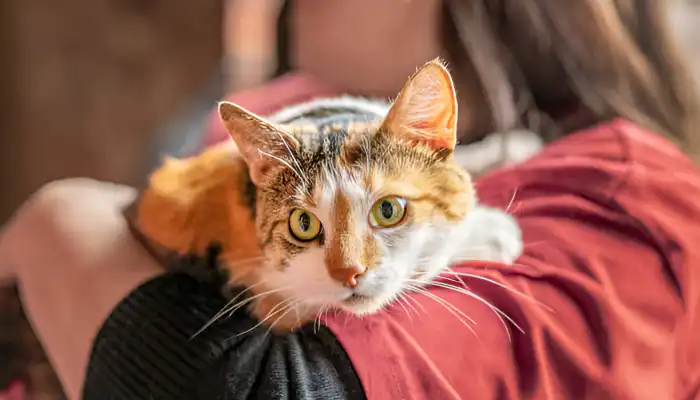How Do Cats Say “Yes”? Just like humans, cats also have their own mean of showing approval, happiness, and trust. Instead of words, their approval comes in the form of slow blinks, purring, head bumps, and tail positions; cats have their own way of saying they are pleased.
Knowing all these happy signals will help strengthen the bond you share with your cat and help you enjoy a trusting relationship. Using a cat translator can further enhance your understanding of these signals. Let us examine the different ways cats say yes and how to encourage cats to say yes more frequently.

Signs That Cats Say “Yes”
How Do Cats Say “Yes”? Cats express their approval and affection through subtle body language and behaviors, making it easy to understand when they are happy and content.
1. Slow Blinking
One of the signs that show a cat loves and trusts its owner is slow blinking. When a cat blinks slowly at you, it shows comfort and contentment with their circumstance. Most feline owners will also slow blink to their companions to express affection and trust.
2. Head Bumping (Bunting)
When a cat head bumps you, they are bunting you which means to claim someone through scent to establish trust and acceptance. Your cat will often display this behavior when it is pleased to see you and your presence and refers to them in a literal sense ‘yes.’
3. Kneading
A cat uses its paws to knead symbolizes happiness and approval. ‘That is my home,’ is what this behavior which stems from infancy declares.
4. Purring
A purr is one of the clearest signs that a cat is satisfied and comfortable in the environment they are in. Though cats can purr in a myriad of situations, a relaxed purr especially when it accompanies other positive body signals is a strong indicator of “Yes!”.
5. Tail Position
A cat’s tail is one of the best indicators of the cat’s mood. A slightly raised tail with a lift at the tip usually suggests that the cat is happy and agrees with the environment. This tail position is a common sign that a cat is sociable and willing to interact.
6. Responding to a Call
A cat that freely walks up to you on hearing its name or seeing food is saying “yes” in its own way. Considering that cats are very independent, their active response is definitely a good sign. When cats actively choose to respond, it is a sign that they approve of what is being offered.
Recognizing these positive signals helps answer the question, How Do Cats Say “Yes”? and strengthens your bond with your cat, ensuring a happy, trusting relationship.
Vocal Cues That Indicate Agreement
Cats do not vocalize as much as dogs do to show approval, but they do have sounds to give us a positive response.
- Chirping and Trilling
- Chirps and trills are pleasant sounds indicating excitement that a cat makes when spotting his or her favorite human.
- Short, Soft Meows
- A gentle, short meow often means a cat is content and acknowledges your presence positively.
- High Pitched Purring Meow
- This combination of purring and meowing often signals excitement and happiness, indicating that a cat is in agreement with its current experience.
Understanding these vocal cues helps you recognize when your cat is expressing joy and approval.
How Cats Say “Yes” Through Actions?
How Do Cats Say “Yes”? Cats also exhibit specific behaviors that demonstrate their approval and willingness to participate in an activity.
| Behavior | Meaning |
|---|---|
| Following You | Indicates trust and approval of your presence. |
| Sitting Close or on You | A sign of affection and comfort. |
| Rolling Over | Shows trust and willingness to engage. |
| Grooming You | A strong signal of acceptance and positive connection. |
Recognizing these behaviors helps strengthen your bond and ensures a positive relationship with your cat.
How to Encourage a Cat to Say “Yes”?
To get your cat to respond positively, here are some pointers on how to work things around with your pet feline.
- Respect Their Boundaries: Let your cat decide when to engage. Some cats prefer controlling the angle of interactions, so it’s best to wait for them to initiate engagement.
- Use Slow Blinks: Slow blinking while looking at the cat will make them feel you want to bond. They will return the action as a trust-enhancing gesture.
- Provide Positive Incentives: Treats and pets are a great way to communicate that positive behavior should be repeated and encourage further good communication.
- Observe Body Language: Identifying the state of comfort versus discomfort in your kitty will only serve to strengthen the bond you already share.
By respecting their boundaries and using positive reinforcement, you can build a trusting and loving bond with your cat.
Conclusion
How Do Cats Say “Yes”? Cats slowly blink their eyes, purr, bump their head onto you and exhibit other affectionate gestures like tailing after you or cuddling close to you which denote approval. The cat’s voice, for example, chirps and meows softly, is another sign of being pleased.
By recognizing these signs and following their rules, you can further your relationship with your cat and develop a trusting relationship that brings you more feline love.
